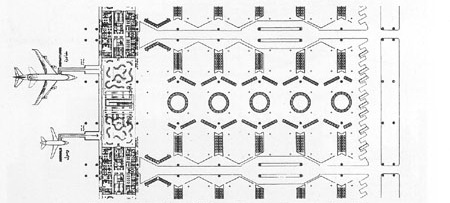Jeddah Architectural Guide|PB/01
صالة الحجاج – مطار الملك عبدالعزيز الدولي |
|
Hajj Terminal -King Abdulaziz International Airport |
|
| PUBLIC BUILDINGS / 01 | |
| 1982 | Skidmore, Owings & Merrill (SOM) |
| 45.70 m | ….. |
| ….. | 260,000 m2 |
| AWARDS | |
| Aga Khan Award 1983 |
|
The Hajj terminal is located near the North Terminal at King Abulaziz International Airport. Vast numbers of pilgrims from all around the world pass through the airport en route to visiting Makkah, located roughly 100 km from the terminal. The architectural firm SOM’s team lead by Gordon Wildermuth, a young American architect who was heading the project at the time, spent endless hours observing the six-week Hajj mass movement in order to place an effective master plan. The design of the terminal had to facilitate handling an enormous number of people with highly varied needs.
After the 1976 approval of Wildermuth’s master plan, design began on the Hajj Terminal itself in 1977, led by Gordon Bunshaft and structural engineer Fazlur-Rahman Khan of SOM.
The building complex, virtually a massive shade canopy covering roughly a one square kilometer area, is independent from the main terminal. Beneath this canopy is where travelers prepare for their trip to Makkah and their return home, with amenities such as food and basic accommodation provided in a series of low rise buildings placed along the main grid of the steel pylons.
SOM’s Fazlur-Rahman Khan’s structural concept suspends the tent units from high masts located at the outer corner edges of each tent. They are combined into two to four column frames. This arrangement gives the architecture, of the world’s largest roof, its potent image. The building is naturally ventilated through the 210 semi-conical, Teflon-coated, glass fibre fabric roof. The units are contained within a total of 10 modules supported by a 45-meter-high steel pylons. This type of architectural fabric has a low heat transmission; and therefore, it allows the sun to cast a warm light over the support area. However, at night it becomes reflective and bounces light illuminating the ground below.
Stepping from the heat of the desert sun into the shade of the Hajj Terminal roof is a defining experience. Completed in 1981, the terminal is original in architecture, hospitable in environment and is one of the most culturally symbolic landmarks in Jeddah, Saudi Arabia.
Shortly after its completion, it received an AIA National Award followed by the Aga Khan Award in 1983. In 2010, the Hajj Terminal received the AIA 25 Year Honour Award for buildings that have “set a precedent and stood the test of time for 25–35 years and that continues to set standards of excellence for its architectural design and significance”.



